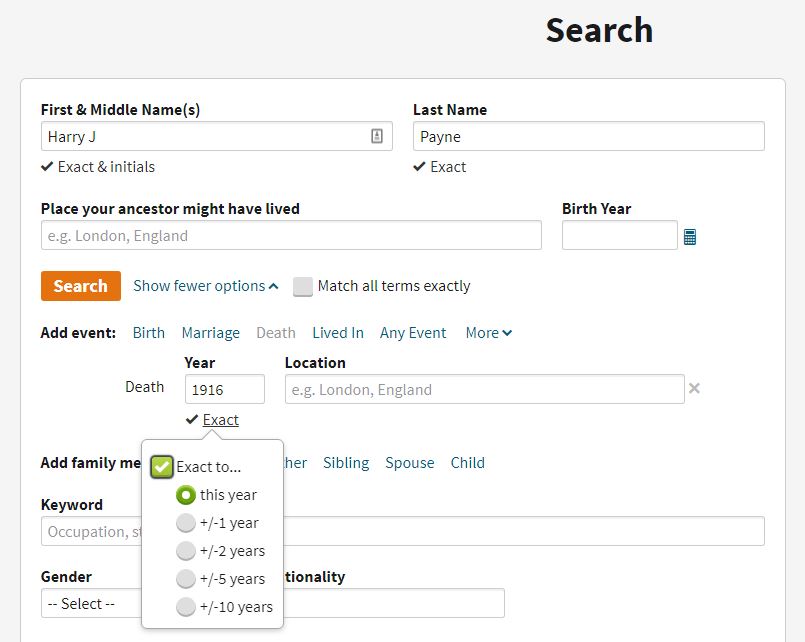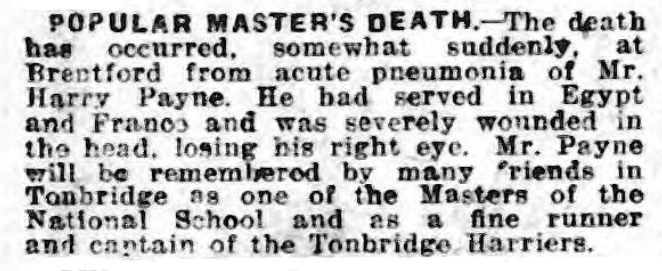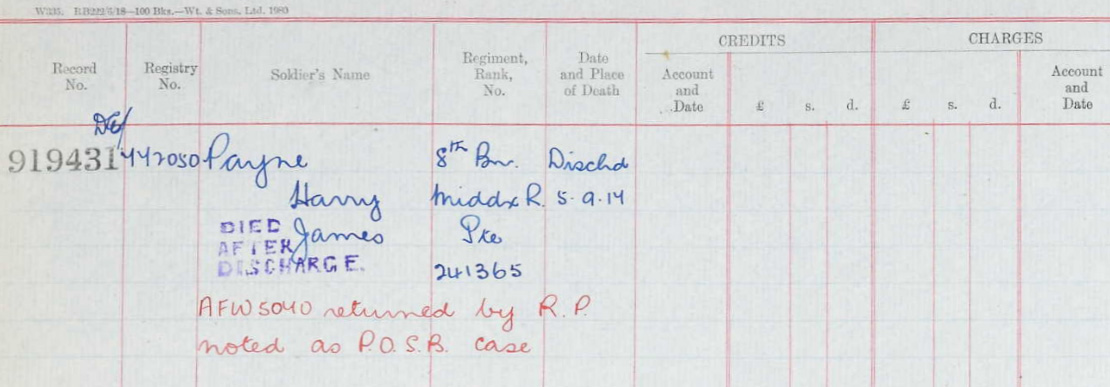
The Hunt for Harry James Payne
Our start-point is, obviously, the chapel rail, giving his name but only the middle initial. To this we can add one further piece of information: in June 1916 the College published a War Supplement, listing all former students serving the armed forces of the Great War, and their whereabouts. All Winchester Training College archives (including those of its later identities King Alfred’s College and University of Winchester) are held at the Hampshire Records Office. Having no budget for the project, almost all work had to be undertaken on-line, but harvesting data from these records was old-fashioned leg-work, ably undertaken by Dee Sayers, one of our three researchers, who lived closest to Winchester. The result, however, was not encouraging: he was simply listed as Pte. H.J. Payne with no location or Regimental information. He was included in the list of men who left college in 1904.
We need to mention at this point that researching every other student was helped tremendously by the previous sterling work of John Hartley (Student 1963-1966). The results of his painstaking work, carried out in pre-Internet days, was committed into the care of others and was tragically lost. The one item which did survive was a spreadsheet summary of his findings, giving most of the following details: Full names, Date of Birth, Date of Death, Date of Studies, Regiment, Service Number, Rank, How Killed, Area of Death, Burial Location. However, Harry J. Payne’s entry is the only one that is blank. There is a note against it which says No details – prob not a war casualty. We were on our own.
Because we did not know his middle name, searches had to be based on Harry J Payne. However, some records do not carry full or middle names, so results had to include Harry Payne, H J Payne and simply H Payne. Reversing names is also common and so J Harry Payne and all of its variants are also possibilities. We also had to bear in mind that Harry may have been a familiar (hypocoristic) name for Henry and that officialdom would tend to record the formal birth name, again with all variations. To add further to the confusion, we knew that there were mistakes made in the carving of one or two of the names in the Chapel Memorial, but this last consideration was something beyond our knowledge or control and had to be discounted.
The work was tedious and was fitted around other research to break the monotony. Candidates were found which sooner or later did not connect with valid death details. Phrases passed between researchers on our messaging thread such as too many results, flogging a dead horse and getting nowhere.
Middlesex Chronicle – Saturday 12 June 1915 (see also British Newspaper Archives in Resources list below)
Looking for one thing often throws up another: in Harry’s case the newspaper searches also helpfully showed us (a) his all-round athleticism in multiple sports carried in numerous articles, (b) a connection with teaching at a school in Tonbridge (still as yet unidentified and dated but almost certainly pre-dating College) and (c) his death details.
Sevenoaks Chronicle and Kentish Advertiser – Friday 28 February 1919
Extract from Army Soldiers Effects Register
But what of the unresolved Esher/Brentford problem? It was during an otherwise fruitless examination of a headmaster’s school diary from Tonbridge that the solution presented itself. The diary included the dates for the beginning and the end of each school term. Cross-referencing these with the dates of the census days, it became clear that the census data was gathered in the Easter school holiday. It had presumably been Harry’s habit to travel home to spend time with his family each Easter break.
Harry’s story was an enigma from beginning to end. It is in keeping therefore that he leaves us with unanswered questions about his time in Tonbridge and, more importantly, why he was included on the Memorial Roll.
The full jigsaw is pieced together in the narrative of Harry’s life.
Researcher and Author of this and the main Harry Payne narrative: John Vickers
Resources
All are free to use unless otherwise stated (£)
This Article
Hampshire Record Office, Sussex Street, Winchester, Hampshire SO23 8TH Tel 01962 846154. Searchable catalogue online available at: http://www3.hants.gov.uk/archives.htm
National Union of Teachers. (1920). War Record 1914“1919. A Short Account of Duty and Work Accomplished During the War. London: NUT. Also available online through FindMyPast (see below).
Rose, M. (1981). A history of King Alfred’s College, Winchester 1840-1980. London: Phillimore.
Military
Great War Forum, (2018). Home page. [online] Available at: www.greatwarforum.org [Accessed 2018].
Imperial War Museum (2018). Home page. [online] Available at: www.iwm.org.uk [Accessed 2018].
The London Gazette. (2018). Home page. [online] Available at: www.thegazette.co.uk [Accessed 2018].
The Long Long Trail, (2018). Welcome to the long long trail. [online] Available at: http://www.longlongtrail.co.uk/ [Accessed 2018].
The National Archives (2018). Home page. [online] Available at: http://www.nationalarchives.gov.uk/ [Accessed 2018].
Wikimedia (2018). Category: World War I – Index to images. [online] Available at: https://commons.wikimedia.org/wiki/Category:World_War_I [Accessed 2018].
General
University of Leicester (2018). Historical Directories of England & Wales – including Kelly’s Directories. [online] Available at: http://specialcollections.le.ac.uk/cdm/landingpage/collection/p16445coll4 [Accessed 2018].
Genealogy Websites
Ancestry www.ancestry.co.uk (£)
FindMyPast www.findmypast.co.uk (£)
FamilySearch www.familysearch.org
The British Newspaper Archive www.britishnewspaperarchive.co.uk (£)





